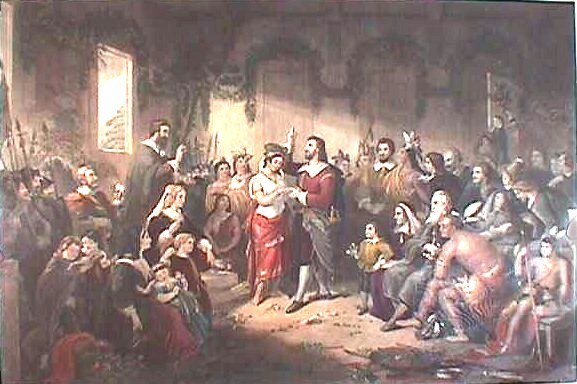Most of my posts deal with current events, but as a historian, I want to highlight key moments in history. Today, for instance, is the anniversary of a special moment in American colonial history: the Powhatan princess Pocahontas married English settler John Rolfe in 1614.
Why is this so important? Pocahontas’s father, Chief Powhatan, had tried to wipe out the Jamestown settlement by starvation just four years earlier. The two cultures weren’t meshing well at all. But when Rolfe and Pocahontas married, the hostility and tension lessened considerably. Prior to the marriage, Pocahontas had been tutored in the Christian faith and accepted what she heard. She asked to be baptized.
This particular painting of the baptism of Pocahontas can be viewed in the Capitol Rotunda in Washington, DC. It’s a little idealized—those columns didn’t exist in colonial Jamestown—but it captures the spirit of the event. She even changed her name to Rebecca, which she considered a more appropriate Christian name.
The Virginia Company knew a good thing when it saw it, so Rebecca and family [she had a young son as well] were all packed and sent to England to show off the good work being accomplished in the New World. While in England, she had her portrait painted in proper English dress.
By all accounts, her conversion was genuine, as was her love of English culture. Unfortunately, before she could return to Virginia, she died of pneumonia. Only a few years later, the peace between the cultures deteriorated. In March of 1622, the natives rose up and tried to exterminate all the English in the Jamestown area. Though they failed in that attempt, any hope for the two cultures to live peaceably side by side disappeared.
But for a few special years, Pocahontas/Lady Rebecca was the cornerstone of good relations. She played a valuable role in early American history.



